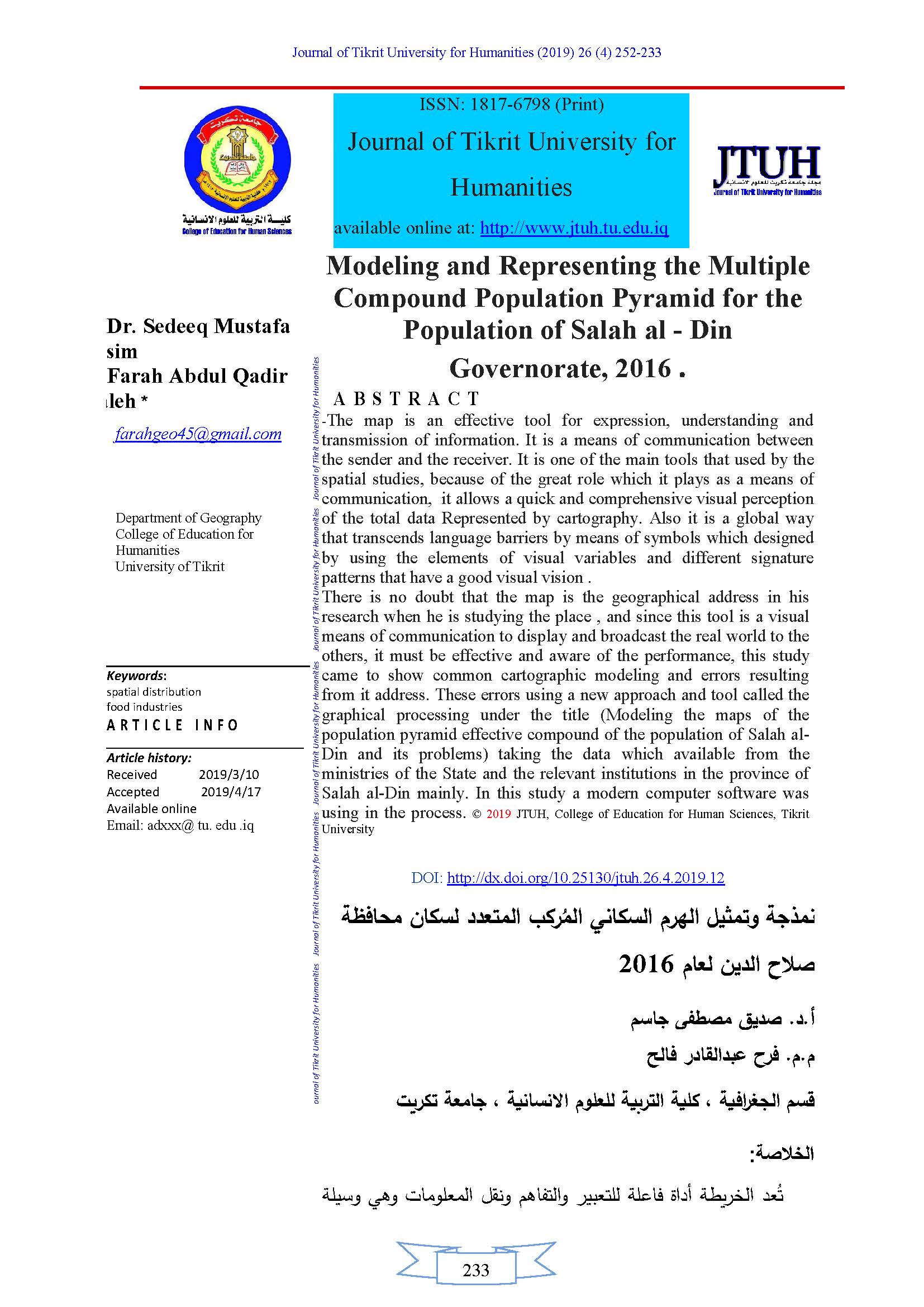Modeling and Representing the Multiple Compound Population Pyramid for the Population of Salah al - Din Governorate, 2016
Main Article Content
Abstract
The map is an effective tool for expression, understanding and transmission of information. It is a means of communication between the sender and the receiver. It is one of the main tools that used by the spatial studies, because of the great role which it plays as a means of communication, it allows a quick and comprehensive visual perception of the total data Represented by cartography. Also it is a global way that transcends language barriers by means of symbols which designed by using the elements of visual variables and different signature patterns that have a good visual vision .
There is no doubt that the map is the geographical address in his research when he is studying the place , and since this tool is a visual means of communication to display and broadcast the real world to the others, it must be effective and aware of the performance, this study came to show common cartographic modeling and errors resulting from it address. These errors using a new approach and tool called the graphical processing under the title (Modeling the maps of the population pyramid effective compound of the population of Salah al-Din and its problems) taking the data which available from the ministries of the State and the relevant institutions in the province of Salah al-Din mainly. In this study a modern computer software was using in the process.
Metrics
Article Details

This work is licensed under a Creative Commons Attribution 4.0 International License.
College of Education for Humanities, TIKRIT UNIVERSITY. THIS IS AN OPEN ACCESS ARTICLE UNDER THE CC BY LICENSE http://creativecommons.org/licenses/by/4.0/
References
(1): wizart almawarid almaaia , alhayaa aiama lelmasaha , masahat alwihdat alidaria llmohafadat alirakia gaam 2010 , Baghdad ,2016 .
(2): Faiz mohamid alesawi , karat altawziaat albasharia (osis watatbikat) , dar alhoriaa liltbaa wa alnashir , Baghdad , s91-92 .
(3): wazart altrbia , almodiria alamaa letarbiat mohafadat salah aldin , nesab alomia wa alkiraa wa alkitabaa wa ashab alshahadat loskan almohafada , sijlat motafarika , Baghdad , 2016 .
(4): wizart altalim alaali waalbaht alilmi , aadad alhasilin ala alshahadat alallia ( diblom ali – master – dictoraaa) fe mohafadat salah aldin , eatmad ala gamiaat tikrit wa sammara liam 2016 .
(5): United Nations, United Nations Development Program, Human Development Report 1994, p. 75 .
(6):George , P. Questions de Geographiede la population , cah , 35 , 1959 .pp.37.
(7): Hunting , E. principles of human geography new york , 1951.pp.94 .
(8): United nation , methods of projecting Economically active population , population studies , No , 46 , New York , 1971 . pp.128 .
(9): fathi abd alaziz abo radi , karat altawziaat albasharia wa rsomha albiania , dar alnahdaa liltbaa wa alnashir wa altawzii , bairot , s115 .
(10): Al-Krenawi, A. (2001). Women from polygamous and monogamous marriages in an out-patient psychiatric clinic Transcultural Psychiatry, 38, 187–199 .
(11): Al-Krenawi, A., & Graham, J. R. (1999). The story of Bedouin-Arab women in a polygamous marriage.Women Studies International Forum, 22, 497–509 . (12): fathi abd alaziz abo radi , karaat altawziaat albasharia wa rsomha albiania , masdar sabik , s117 .
(13): mansor alrawi , drasat fe alsocan wa altanmiaa , bayt alhikma liltbaa wa alnashir , 1989 , s66 .
(14): Anand , Ravallion , Human Development in poor countries : on the role of private in comes an public services , Journal of economic perspectives ,winter ,1993 ,pp.167.
(15)- United Nations, United Nations Development Program, Human Development Report 1994, p. 90.
(16)- monir talaat al-rashidi , karaat altawziaat albasharia , aliskandaria , gameat aliskandaria , s387 .




